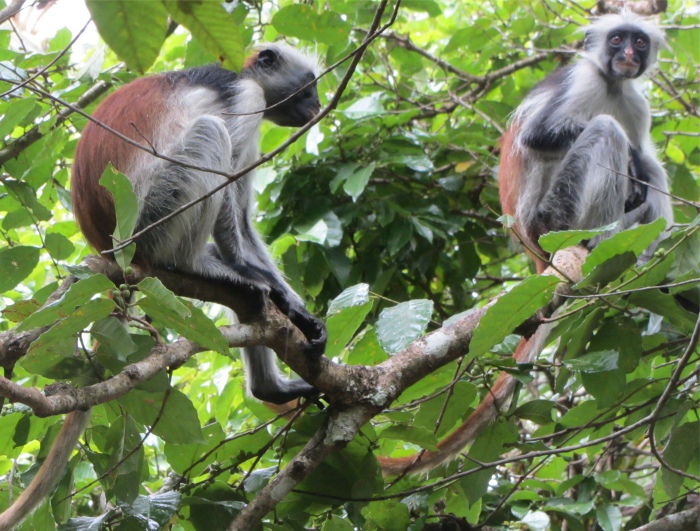 Pair of Red Colobus Monkeys |
Half an hour after sunrise and the sun was blisteringly hot. Few clouds blemished the cobalt blue sky. Sally would have liked to have an early morning swim in the cooler morning tide. However, we were due to be picked up at 9am, so that was out of the question. While the maintenance man tried to ascertain why our bungalow was tripping the power, I lazily sat on a swing seat watching a group of four women operate nets near the shore to catch small fry.
 Colobus Eating Unripe Guava. Notice the Four Fingers and No Thumb |
The three of us assembled at 9am, to be introduced by Laura to Haji, who would act as our driver for our trip to Jozani-Chwaka Bay Conservation Area, the only national park in Zanzibar, some way back along the road to Stone Town. Once there, we were introduced to Salim who would act as our guide for the next couple of hours.
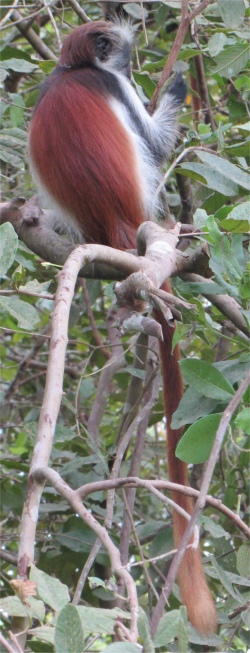 Long Tailed Red Colobus |
One of Africa's rarest primates, the indigenous Zanzibar Red Colobus may number only about 1500. Isolated on this island for at least 10,000 years, this colobus is recognised as a distinct species, with different coat patterns, calls and food habits than related colombus species on the mainland. About one third of the Red Colobus live in and around Jozani Forest.
One of the most striking features of the Red Colobus is a crown of long, white hairs which fans out around the face in tufts. The face is mainly black with pink areas around the mouth and nose. The back of the head and back are very red, separated by a black stripe across the shoulders which continues down the arms. The tail has varying shades of red, often graduating to a sandy orange. The name Colobus originated from a word that means "mutilated" or "docked," referring to the monkey's lack of thumbs on its hands, something all species of Colobus monkeys have in common. This allows them to use their four long fingers to wrap around branches while they swing through the canopy.
 Small Apple on Forest Apple Tree |
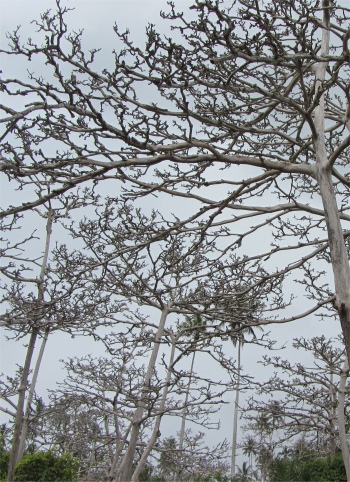 Almond Trees Stripped Bare by Colobus Monkeys |
And within a couple of minutes it was completely lashing it down, which we three found totally exhilarating in the fierce heat. Whilst we were tracking the monkeys through woodland, I observed one high up having a long (timewise as well as heightwise) pee. When he had concluded his business, my eyes dropped down to where the jet had cascaded, and spotted a small rotund lady wearing a baseball cap with a very damp patch on it. She had obviously not distinguished it from the rain; probably best I keep quiet I thought.
A big tree with large rubbery-looking, dark green leaves loomed ahead of us. Salim explained that it was a forest apple tree. He pointed out a small red apple, which would grow to a fist sized proportion, enjoyed by the monkeys.
Nearby stood a stand of dead trees. These were almond trees, totally stripped bare by the monkeys. The pesky little fellows did not drink water from pools, relying completely on obtaining moisture from whatever they ate. Almond tree leaves hold particularly high quantities of water, hence the trees being completely stripped of their leaves.
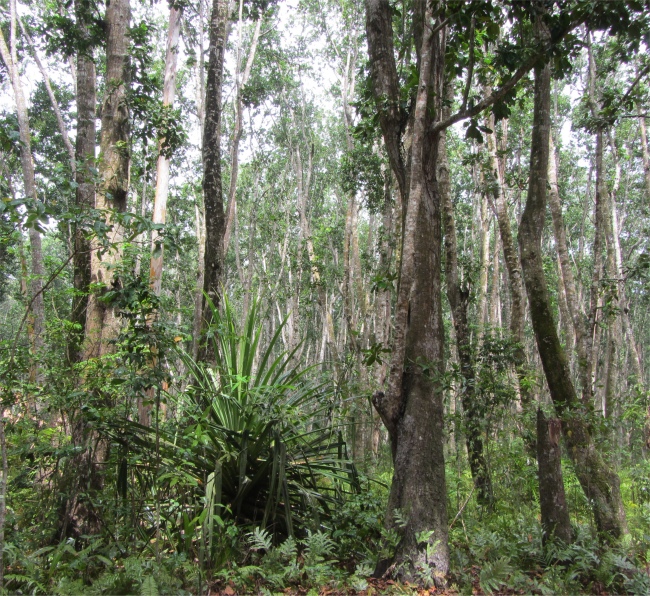 Mahogany Stand |
We came across figs growing near the base of a fig tree, and a profusion of delicate blue flowers which locals used as vegetables.
Salim then took us across to the Jozani Forest, the largest near-natural forest on the island, and immediately identified by the height of the trees. The forest lies in a shallow trough in the fossil coral bed between the mangrove filled Chwaka Bay in the north and Uzi Bay to the south. Seasonal flooding, and a high water table, has given rise to a unique groundwater forest. On the high ground to either side is dry coral rag forest and thicket.
In a torrential downpour, we passed through a stand of mahogany trees. Rapping my knuckles on one of these was like striking concrete. A mahogany seed was lying on the forest floor, resembling a horse chestnut without the prickles. Inside was a nut which locals would grind up with palm oil to produce an ear treatment solution. Indeed, Salim mentioned that locals relied a lot on herbal remedies. A large oil palm bush served as a reminder of how many countries use this plant as a source of oil.
We continued our walk through an ocean of lush ferns, marvellously rich in green shades, glistening after the recent downpour, the smell intoxicating, taking me back 50 years to when I used to walk through fern filled woods in the English Lake District. Sunlight played in many ways through the foliage. Salim explained that the water table was only a metre below the forest floor, and he would occasionally come across fresh water crabs in the forest.
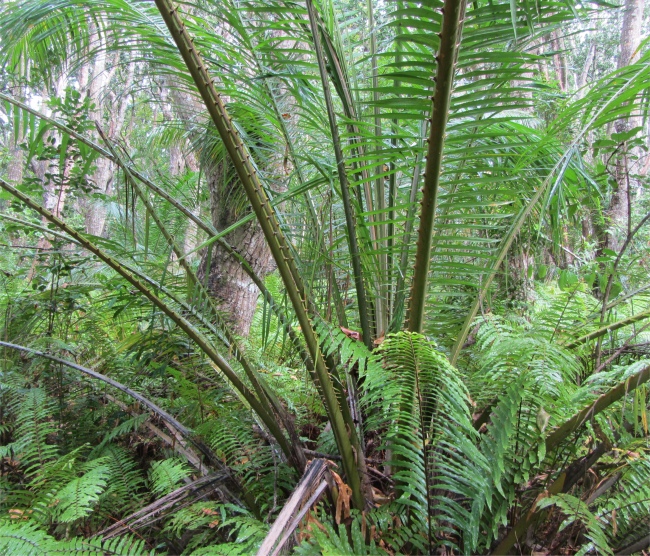 Oil Palm |
Not far away was a tall, straight pandanus tree. These trees have thin sword like leaves up to 1m. long, sprouting from the branch-ends, and roots hang down from various parts of the trunk to anchor the tree into the ground. The roots were sometimes boiled and eaten by locals.
Salim casually nodded to a fork of another tree in which a large black millipede was tap-dancing his way through. This lad had the eyes of a hawk.
As we made our way to a mangrove swamp, I asked the young man how he had acquired his skills, he told us he had studied for four years at university in Kilimanjaro, obtaining a degree in wild life studies. He was now one of the forest rangers who guided foreign tourists.
He took us along a boardwalk suspended above a tidal mangrove swamp that was linked to the Indian Ocean 3km away. Major mangrove species include Rhizophora mucronata (Mkoko), Ceriops tagal (Mkandaa), and Avicennia marina (Mchu). These trees may be less cute than the monkeys but of critical importance to the island's health as they help to protect Zanzibar from coastal erosion, purify its waters and provide nutrition for the outlying coral reefs, which in turn play host to much of the archipelago's marine life. The brackish water that flowed through the mangrove was a nursery ground for hundreds of species of tropical fish, some of which could be seen feeding in the shallow waters, whilst crabs and other molluscs could be observed feasting in the nutrient rich mud.
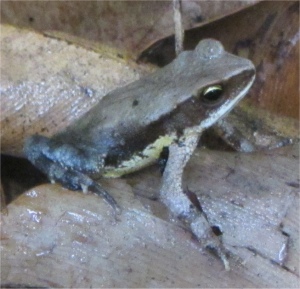 Tree Frog |
Exploring the Jozani Forest and mangrove swamp, plus seeing the Red Colobus Monkeys close up in the rain, made a very pleasant change from the beach. We had all learnt something and really enjoyed it.
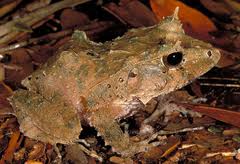 Leaf Frog |
Later in the afternoon, Dan and I went snorkelling using the locally based dhow as a means of getting close to the coral reef. Sadly, there wasn't a breath of wind when we headed out, so if was a case of our vessel being poled out to the deeper waters, but not to worry. On reaching the reef, our anchor was dropped, and we dropped over the side of the dhow. The first thing I did was check that I could take pictures successfully using Sally's underwater camera that she had kindly lent me. I had taken a couple of photos on our way out to the reef, but once the camera was in the water, it stopped working. I tinkered with it for a while, but could I get it working? No was the answer. I deduced that the battery had flattened. It was a deeply disappointing situation, but these things happen, so I left the camera in the dhow and headed out towards the reef.
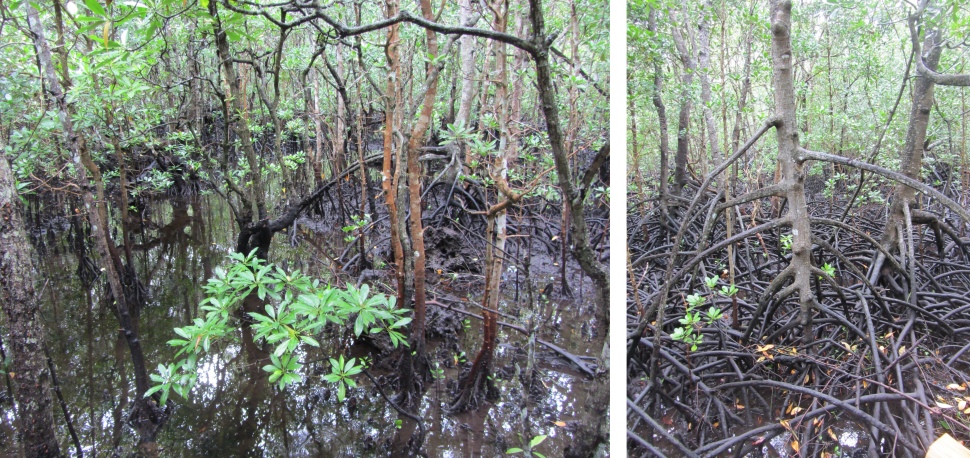 Mangrove Swamp |
As I pushed further towards the reef, I encountered the seabed ablaze with a profusion of vivid clashing soft corals in lime greens, pinks, purples, reds, pearl, oranges and even resembling beds of heather. There was also a surfeit of shapes: large round nodules, beds of broken concrete, and clumps of fluted coral - Neptune's organ pipes perhaps. Tucked in the crevices and in colonial swathes lurked myriads of sea urchins.
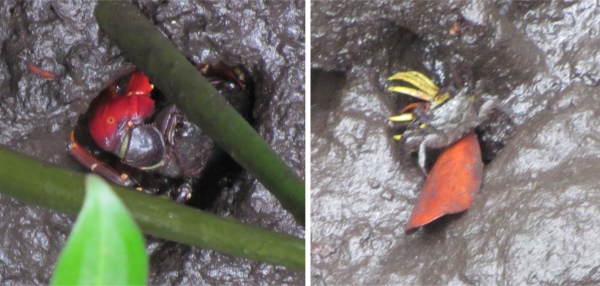 Mangrove Swamp Crabs |
Exposed areas of sandy seabed were littered with oyster shells, round sea urchin skeletons, and long defunct clam shells. I spied a live clam with a delicate, velvety, green fleshy lining around its orifice.
Some of the starfish I glimpsed were stunning. One group had grey, rubbery bodies, about 40cm across, with crimson "stalagmites" sprouting on their upper surface, all joined by a feathery pattern of red markings. Another I saw resembled a purple patterned pin cushion, as if it had been inflated by a pump.
I swam out quite a way, getting stung constantly by tiny translucent and ghostly jellyfish hanging in the water. I drifted lazily back with the tide to the dhow, near which Dan had based his exploration, then I headed back out to the reef again.
During my foray over the reef, I turned to check my position with respect to the dhow in order to get my bearings. However, by now the sun was lower in the sky, such that I was dazzled by its reflection off the water, and I could not make anything out at all. Playing safe, I headed slowly back shoreward to try and locate it. I was in no particular hurry, and leisurely swam, occasionally popping my head out of the water to try and get a fix. I thought I caught sight of a mast in the distance and used that as my bearing. I wasn't sure if I heard a call, but couldn't make it out if it was one, so I worked my way slowly back to the dhow.
 Cows Taking Themselves for a Stroll Along the Beach While Folk Collect Shellfish on the Sand Flats |
The skipper had been busy catching his supper while we were in the water.
 Sally Chilling Out |
Sally had been chilling out on one of the sunbeds, chatting to one of the other guests, a Swiss chap. He worked in Africa, involved in providing the logistics for the cocoa industry, ensuring cocoa is collected from the smallest of farms, regionally marshalled, and eventually shipped to the big users in Europe such as Cadburys. At times he had to be imaginative, such as the time when turmoil in one particular country necessitated cocoa being smuggled across a border.
With the first stars blinking over the palms, we returned to the restaurant we had failed to find the other evening for our best meal on the east coast of the island. We could not help but overhear a loud American on the next table boasting about how he was exploiting folk in Kenya. Indeed a couple who were with him left in embarrassment. Sally recognised the bigmouth from Kisumu, and was hopping mad about his exploitation, and even more so with the Kenyan's for letting him get away with it.
The restaurant had Wi-Fi, allowing Dan to catch up with the latest football results , while Sally thrashed me soundly at Rummy again.
